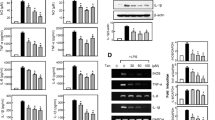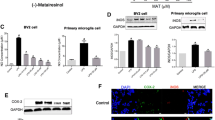Abstract
Inflammation and oxidative stress have been reported to play critical roles in the pathogenesis of neurodegenerative disease. Forsythiaside A, a phenylethanoside product isolated from air-dried fruits of Forsythia suspensa, has been reported to have anti-inflammatory and antioxidant effects. In this study, the anti-inflammatory effects of forsythiaside A on LPS-stimulated BV2 microglia cells and primary microglia cells were investigated. The production of inflammatory mediators TNF-α, IL-1β, NO and PGE2 were detected in this study. NF-κB, nuclear factor-erythroid 2-related factor 2 (Nrf2), heme oxygenase-1 (HO-1) expression were detected by western blot analysis. Our results showed that forsythiaside A significantly inhibited LPS-induced inflammatory mediators TNF-α, IL-1β, NO and PGE2 production. LPS-induced NF-κB activation was suppressed by forsythiaside A. Furthermore, forsythiaside A was found to up-regulate the expression of Nrf2 and HO-1. In conclusion, this study demonstrates that forsythiaside A inhibits LPS-induced inflammatory responses in BV2 microglia cells and primary microglia cells through inhibition of NF-κB activation and activation of Nrf2/HO-1 signaling pathway.





Similar content being viewed by others
References
Hirsch EC, Hunot S (2009) Neuroinflammation in Parkinson’s disease: a target for neuroprotection? Lancet Neurol 8:382–397
Mosley RL, Benner EJ, Kadiu I, Thomas M, Boska MD, Hasan K et al (2006) Neuroinflammation, oxidative stress and the pathogenesis of Parkinson’s disease. Clin Neurosci Res 6:261–281
Liu B, Hong JS (2003) Role of microglia in inflammation-mediated neurodegenerative diseases: mechanisms and strategies for therapeutic intervention. J Pharmacol Exp Ther 304:1–7
Park HY, Han MH, Park C, Jin CY, Kim GY, Choi IW et al (2011) Anti-inflammatory effects of fucoidan through inhibition of NF-kappa B, MAPK and Akt activation in lipopolysaccharide-induced BV2 microglia cells. Food Chem Toxicol 49:1745–1752
Zhong LM, Zong Y, Sun L, Guo JZ, Zhang W, He Y et al (2012) Resveratrol inhibits inflammatory responses via the mammalian target of rapamycin signaling pathway in cultured LPS-stimulated microglial cells. Plos One 7:e32195
Yu Z, Tang L, Chen L, Li J, Wu W, Hu C (2015) Capillarisin suppresses lipopolysaccharide-induced inflammatory mediators in BV2 microglial cells by suppressing TLR4-mediated NF-kappaB and MAPKs signaling pathway. Neurochem Res 40:1095–1101
Zhang Y, Chen WA (2015) Biochanin A inhibits lipopolysaccharide-induced inflammatory cytokines and mediators production in BV2 microglia. Neurochem Res 40:165–171
Qu H, Zhang Y, Wang Y, Li B, Sun W (2008) Antioxidant and antibacterial activity of two compounds (forsythiaside and forsythin) isolated from Forsythia suspensa. J Pharm Pharmacol 60:261–266
Kim JM, Kim S, Kim DH, Lee CH, Park SJ, Jung JW et al (2011) Neuroprotective effect of forsythiaside against transient cerebral global ischemia in gerbil. Eur J Pharmacol 660:326–333
Huang C, Lin Y, Su H, Ye D (2015) Forsythiaside protects against hydrogen peroxide-induced oxidative stress and apoptosis in PC12 cell. Neurochem Res 40:27–35
Cheng G, Zhao Y, Li H, Wu Y, Li X, Han Q et al (2014) Forsythiaside attenuates lipopolysaccharide-induced inflammatory responses in the bursa of Fabricius of chickens by downregulating the NF-κB signaling pathway. Exp Ther Med 7:179–184
Pan C-W, Zhou G-Y, Chen W-L, Zhuge L, Jin L-X, Zheng Y et al (2015) Protective effect of forsythiaside A on lipopolysaccharide/d-galactosamine-induced liver injury. Int Immunopharmacol 26:80–85
Zhou L, Yang H, Ai Y, Xie Y, Fu Y (2014) Protective effect of forsythiaside A on acute lung injure induced by lipopolysaccharide in mice. Xi Bao Yu Fen Zi Mian Yi Xue Za Zhi 30:151–154
Park J, Min JS, Kim B, Chae UB, Yun JW, Choi MS et al (2015) Mitochondrial ROS govern the LPS-induced pro-inflammatory response in microglia cells by regulating MAPK and NF-kappaB pathways. Neurosci Lett 584:191–196
Monji A, Kato TA, Mizoguchi Y, Horikawa H, Seki Y, Kasai M et al (2013) Neuroinflammation in schizophrenia especially focused on the role of microglia. Prog Neuropsychopharmacol Biol Psychiatry 42:115–121
Scheld WM, Koedel U, Nathan B, Pfister H-W (2002) Pathophysiology of bacterial meningitis: mechanism (s) of neuronal injury. J Infect Dis 186:S225–S233
Qin L, Li G, Qian X, Liu Y, Wu X, Liu B et al (2005) Interactive role of the toll-like receptor 4 and reactive oxygen species in LPS-induced microglia activation. Glia 52:78–84
Wang AL, Albert C, Lau LT, Lee C, Tso MO (2005) Minocycline inhibits LPS-induced retinal microglia activation. Neurochem Int 47:152–158
Im NK, Zhou W, Na M, Jeong GS (2015) Pierisformoside B exhibits neuroprotective and anti-inflammatory effects in murine hippocampal and microglial cells via the HO-1/Nrf2-mediated pathway. Int Immunopharmacol 24:353–360
Munoz L, Ammit AJ (2010) Targeting p38 MAPK pathway for the treatment of Alzheimer’s disease. Neuropharmacology 58:561–568
Wang CX, Shuaib A (2002) Involvement of inflammatory cytokines in central nervous system injury. Prog Neurobiol 67:161–172
Shakibaei M, John T, Seifarth C, Mobasheri A (2007) Resveratrol inhibits IL-1β-induced stimulation of caspase-3 and cleavage of PARP in human articular chondrocytes in vitro. Ann N Y Acad Sci 1095:554–563
Sanz-Rosa D, Oubina MP, Cediel E, de las Heras N, Vegazo O, Jimenez J et al (2005) Effect of AT1 receptor antagonism on vascular and circulating inflammatory mediators in SHR: role of NF-κB/IκB system. Am J Physiol Heart Circ Physiol 288:H111–H115
Lee I-S, Lim J, Gal J, Kang JC, Kim HJ, Kang BY et al (2011) Anti-inflammatory activity of xanthohumol involves heme oxygenase-1 induction via NRF2-ARE signaling in microglial BV2 cells. Neurochem Int 58:153–160
Lee S, Suk K (2007) Heme oxygenase-1 mediates cytoprotective effects of immunostimulation in microglia. Biochem Pharmacol 74:723–729
Li WG, Khor TO, Xu CJ, Shen GX, Jeong WS, Yu S et al (2008) Activation of Nrf2-antioxidant signaling attenuates NF kappa B-inflammatory response and elicits apoptosis. Biochem Pharmacol 76:1485–1489
Ishii T, Itoh K, Takahashi S, Sato H, Yanagawa T, Katoh Y et al (2000) Transcription factor Nrf2 coordinately regulates a group of oxidative stress-inducible genes in macrophages. J Biol Chem 275:16023–16029
Acknowledgments
This study was supported by Grants from the ‘Neuroprotective effects of microRNA-124 on dopaminergic neurons in Parkinson’s disease and its related mechanism (81371397)’ and The Guangdong Provincial Clinical Medical Centre for Neurosurgery (No. 2013B0204000 05).
Author information
Authors and Affiliations
Corresponding author
Ethics declarations
Conflict of interest
All authors declare that they have no conflict of interest.
Rights and permissions
About this article
Cite this article
Wang, Y., Zhao, H., Lin, C. et al. Forsythiaside A Exhibits Anti-inflammatory Effects in LPS-Stimulated BV2 Microglia Cells Through Activation of Nrf2/HO-1 Signaling Pathway. Neurochem Res 41, 659–665 (2016). https://doi.org/10.1007/s11064-015-1731-x
Received:
Revised:
Accepted:
Published:
Issue Date:
DOI: https://doi.org/10.1007/s11064-015-1731-x




